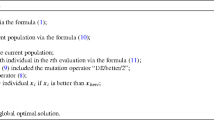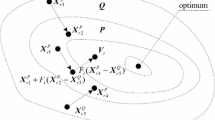Abstract
The differential evolution (DE) algorithm is a notably powerful evolutionary algorithm that has been applied in many areas. Therefore, the question of how to improve the algorithm’s performance has attracted considerable attention from researchers. The mutation operator largely impacts the performance of the DE algorithm The control parameters also have a significant influence on the performance. However, it is not an easy task to set a suitable control parameter for DE. One good method is to considering the mutation operator and control parameters simultaneously. Thus, this paper proposes a new DE algorithm with a hybrid mutation operator and self-adapting control parameters. To enhance the searching ability of the DE algorithm, the proposed method categorizes the population into two parts to process different types of mutation operators and self-adapting control parameters embedded in the proposed algorithm framework. Two famous benchmark sets (including 46 functions) are used to evaluate the performance of the proposed algorithm and comparisons with various other DE variants previously reported in the literature have also been conducted. Experimental results and statistical analysis indicate that the proposed algorithm has good performance on these functions.














Similar content being viewed by others
Explore related subjects
Discover the latest articles, news and stories from top researchers in related subjects.References
Storn R, Price K (1997) Differential evolution – a simple and efficient heuristic for global optimization over continuous spaces. J Glob Optim 11(3):341–359
Onwubolu G, Davendra D (2006) Scheduling flow shops using differential evolution algorithm. Eur J Oper Res 171(2):674– 692
Yildiz AR (2013) A new hybrid differential evolution algorithm for the selection optimal machining parameters in milling operations. Appl Soft Comput 13(3):1561–1566
Storn R (1999) System design by constraint adaption and differential evolution. IEEE Trans Evol Comput 3(1):22–34
Vafashoar R, Meybodi MR, Momeni Azandaryani AH (2012) CLA-DE: a hybrid model based on cellular learning automata for numerical optimization. Appl Intell 36(3):735–745
Das S, Suganthan PN (2011) Differential evolution: a survey of the state-of-the-art. IEEE Trans Evol Comput 15(1):4–31
Neri F, Tirronen V (2010) Recent advances in differential evolution: a survey and experimental analysis. Artif Intell Rev 33(1–2):61–106
Islam SM, Das S, Ghosh S, Subhrajit Roy (2012) An adaptive differential evolution algorithm with novel mutation and crossover strategies for global numerical optimization. IEEE Trans Syst Man Cybern Part B: Cybern 42(2):482–500
Ali MM (2011) Differential evolution with generalized differentials. J Comput Appl Math 235(80):2205–2216
Thangaraj R., Pant M., Abraham A. (2010) New mutation schemes for differential evolution algorithm and their application to the optimization of directional over-current relay settings. Appl Math Comput 216(5):532–544
Han MF, Liao SH, Chang JY, Lin CT (2013) Dynamic group-based differential evolution using a self-adaptive strategy for global optimization problems. Appl Intell 39(5):41–56
Brest J., Greiner S., Boskovic B., Zemer V. (2006) Self-adapting control parameters in differential evolution: A comparative study on numerical benchmark problems. IEEE Trans Evol Comput 10(5):646–657
Liu J, Lampinen J (2005) A fuzzy adaptive differential evolution algorithm. Soft Comput 9(5):448–462
Neri F, Tirronen V (2009) Scale factor local search in differential evolution. Memetic Comput 1(2):153–171
Qin AK, Huang VL, Suganthan PN (2009) (2009), Differential evolution algorithm with strategy adaptation for global numerical optimization. IEEE Trans Evol Comput 13(2):398–417
Zhou Y, Li X, Gao L (2013) A differential evolution algorithm with intersect mutation operator. Appl Soft Comput 13(2):390–401
Fan H, Lampinen J (2003) A trigonometric mutation operation to differential evolution. J Global Optim 27(1):105–129
Das S, Abraham A, Chakraborty UK, Konar A (2009) Differential evolution using a neighborhood-based mutation operator. IEEE Trans Evol Comput 13(3):526–553
Rahnamayan S, Tizhoosh HR, Salama MMA (2009) Opposition-based differential evolution. IEEE Trans Evol Comput 13(3):398–417
Mallipeddi R, Suganthan PN, Pan QK, Tasgetiren MF (2011) Differential evolution algorithm with ensemble of parameters and mutation strategies. Appl Soft Comput 11(20):1679–1696
Gamperle R, Muler S, Koumoutsakos P. (2002) A parameter study for differential evolution. In: Proc. WSEAS Int. Conf. Advances Intell Syst. Fussy Syst. Evol. Comput.
Pan Quanke, Suganthan PN, Wang Ling, Gao Liang, Mallipeddi R (2011) A differential evolution algorithm with self-adaptive strategy and control parameters. Comput Oper Res 38(1):394– 408
Epitropakis MG, Tasoulis DK, Pavlidis NG., Vassilis PP, Vrahatis MN (2011) Enhancing differential evolution utilizing proximity-based mutation operators. IEEE Trans Evol Comput 15(1):99–119
Wang Y, Cai Z, Zhang Q (2011) Differential evolution with composite trail vector generation strategies and control parameters. IEEE Trans Evol Comput 15(1):55–66
Civicioglu P (2012) Transforming geocentric Cartesian coordinates to geodetic coordinates by using differential search algorithm. Comput Geosci 46:229–247
Yao X, Liu Y, Lin G (1999) Evolutionary programming made faster. IEEE Trans Evol Comput 3(2):82–102
Suganthan PN, Hansen N, Liang JJ, Deb K, Chen YP, Auger A, Tiwari S (2005 ) Problem definitions and evaluation criteria for CEC 2005 special session on real-parameter optimization, Nanyang Technol. Uni., Singapore. http://www.ntu.edu.sg/home/EPNSugan
Acknowledgments
This research work is supported by the National Basic Research Program of China (973 Program) under Grant no. 2011CB706804 and the Natural Science Foundation of China (NSFC) under Grant nos. 51375004 and 51435009.
Conflict of interests
The authors declare that there is no conflict of interests regarding the publication of this paper.
Author information
Authors and Affiliations
Corresponding author
Appendices
Appendix A: Benchmark set 1
Appendix B: Benchmark set 2
The last thirteen benchmark functions in benchmark set 2 are hybrid composite functions, which consist of up to ten sub-functions. In the following, only the first twelve benchmark functions are listed. For more details on this benchmark set, please refer to Suganthan et al. [27]
Rights and permissions
About this article
Cite this article
Yi, W., Gao, L., Li, X. et al. A new differential evolution algorithm with a hybrid mutation operator and self-adapting control parameters for global optimization problems. Appl Intell 42, 642–660 (2015). https://doi.org/10.1007/s10489-014-0620-3
Published:
Issue Date:
DOI: https://doi.org/10.1007/s10489-014-0620-3




